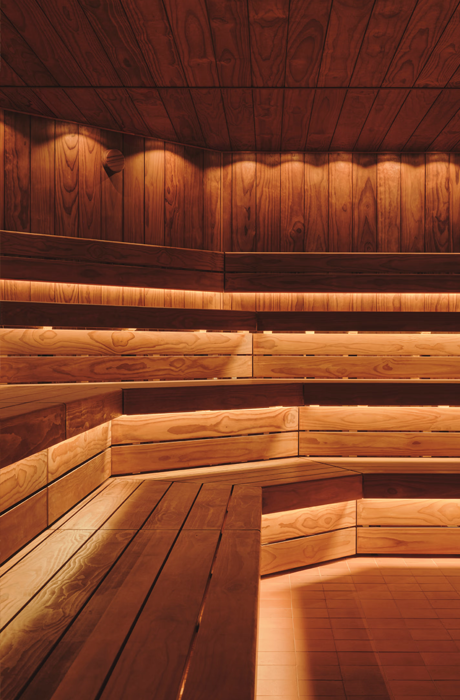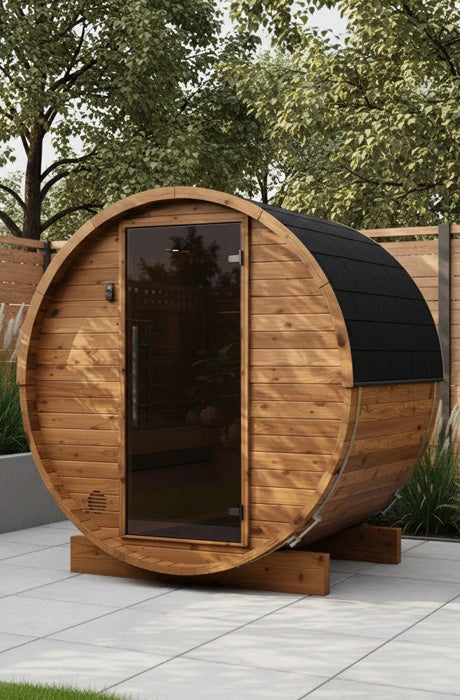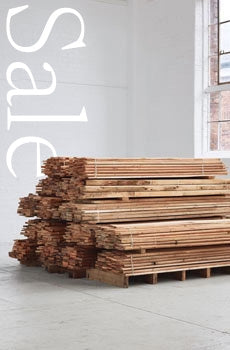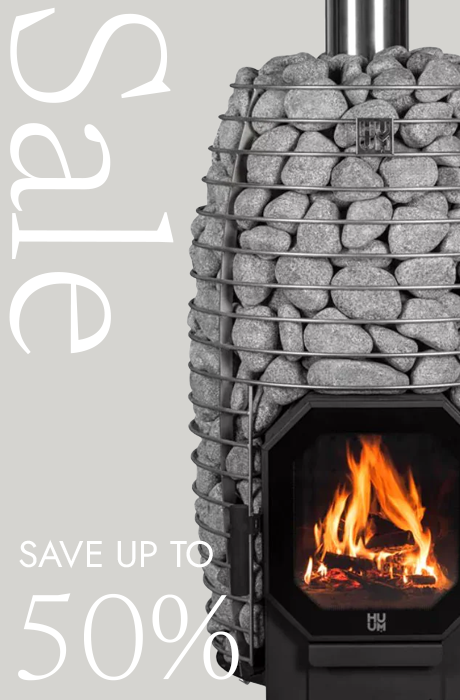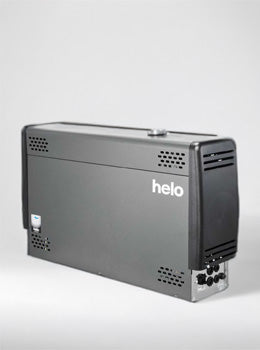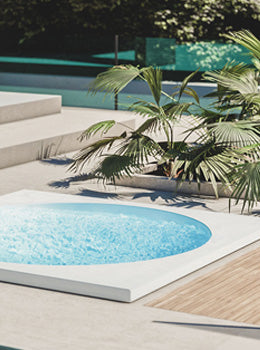
How To Clean Your Sauna Wood: The Complete Guide | Finnmark Sauna
Having the proper knowledge on how to clean and treat your sauna wood is essential for maintaining the longevity, hygiene, and aesthetic appeal of your sauna. Whether you operate a commercial spa facility or own a domestic installation, understanding how to maintain sauna timber correctly has many long-term benefits. It prevents decay, eliminates bacteria and preserves the natural beauty of your wooden surfaces - potentially for decades to come.
This comprehensive guide covers everything you need to know about cleaning sauna wood, from daily maintenance routines to deep cleaning protocols for both residential and commercial environments. We'll explore the specialist products designed specifically for sauna timber and demonstrate proper cleaning techniques that protect wood fibres whilst preventing common issues such as discolouration, mould growth, and premature deterioration.
Why Sauna Wood Requires Specialist Cleaning
Sauna timber exists in an exceptionally challenging environment. The combination of high heat, fluctuating moisture levels, and organic matter from human use creates conditions where bacteria, mould, and structural damage can rapidly develop if proper cleaning protocols aren't maintained.
Traditional softwoods used in sauna construction, such as Nordic spruce, aspen, alder, and heat-treated Thermowood, are naturally porous and absorbent. This porosity allows these timbers to breathe and regulate humidity effectively, but it also means they readily absorb sweat, oils, skin cells, and moisture. When these substances penetrate the wood fibres, they create the perfect breeding ground for bacteria and fungi whilst causing staining, odours, and eventual decay.
Unlike treated or sealed woods used elsewhere in your home, sauna timber must remain untreated on interior surfaces to maintain its breathability and prevent toxic fumes when heated. This means you cannot use standard household cleaning products, varnishes, or protective coatings. Instead, sauna wood cleaning requires specialist products formulated specifically to clean, protect, and preserve untreated timber without compromising its natural properties or creating health hazards.
Regular cleaning of sauna wood prevents sweat and oils from impregnating the timber, eliminates bacteria and mould before they establish colonies, maintains the natural light colour and grain pattern of the wood, prevents unpleasant odours from developing, and protects your investment by extending the lifespan of expensive timber components.
Essential Products for Cleaning Sauna Wood
Using appropriate cleaning products specifically formulated for sauna timber is crucial for effective maintenance without causing damage.
Specialist Sauna Wood Cleaner
Professional sauna wood cleaner is specifically formulated to remove sweat, oils, and bacteria from untreated timber without damaging wood fibres or leaving harmful residues. Unlike household cleaners, specialist sauna cleaners are pH-balanced for wood, free from harsh chemicals that create toxic fumes when heated, designed to clean effectively without over-saturating timber, and safe for repeated use on untreated surfaces.
When selecting a sauna wood cleaner, ensure it's specifically designed for sauna use, suitable for your timber type, and concentrated enough to be cost-effective when diluted. A quality sauna cleaner should effectively remove dirt, sweat, and light staining whilst maintaining the wood's natural breathability and appearance.
Paraffin Oil for Sauna Wood Protection
Paraffin Oil is not to be confused with Paraffin, which is a highly flammable substance used to fuel kerosene lamps. To avoid this serious mistake, please make sure that you always source your timber treatment products from a sauna specialist. Paraffin oil represents the gold standard for sauna wood conditioning and protection. This highly stable white mineral oil—the primary constituent in baby oil and massage oil—is dermatologically safe, skin-friendly, and creates an exceptional protective barrier on sauna timber.
The benefits of paraffin oil treatment include creating a moisture-resistant barrier that prevents sweat and oils from penetrating deeply into wood fibres, significantly reducing staining and discolouration, making the timber surface easier to clean in subsequent sessions, enhancing the natural grain pattern and colour of the wood, and extending the overall lifespan of your sauna timber.
Paraffin oil application should occur after thorough cleaning when the wood is completely dry. The treatment darkens timber slightly, creating a richer, more uniform appearance whilst protecting against future damage. For domestic saunas, annual or bi-annual application is typically sufficient. Commercial installations with heavy use may benefit from quarterly treatments on high-contact surfaces such as bench tops.

Natural Cleaning Alternatives
For light maintenance between specialist cleaning sessions, several natural products can safely clean sauna wood:
White vinegar solution (1 part vinegar to 3 parts warm water) effectively removes light staining and has natural antibacterial properties. This solution is ideal for weekly wipe-downs in domestic saunas and is safe for all wood types.
Baking soda paste (3 parts baking soda to 1 part water) creates a gentle abrasive that effectively removes stubborn sweat stains without scratching timber. Apply to the stained area, allow to sit for 5-10 minutes, scrub gently with a soft brush, and rinse thoroughly.
Essential Cleaning Tools
Proper tools ensure effective cleaning without damaging delicate wood surfaces:
-
Soft-bristle or medium-stiff brush: Choose brush stiffness based on the cleaning intensity required.
-
Microfibre cloths: Essential for wiping and drying without leaving lint.
-
Bucket for diluting cleaners: Always dilute concentrated sauna wood cleaner according to the manufacturer's instructions.
-
Mop with a removable head: For floor cleaning without oversaturating timber.
-
Fine-grit sandpaper (150-180 grit): For periodic sanding to remove ingrained stains.
-
Vacuum cleaner with soft brush attachment: Essential for removing loose debris before wet cleaning.
Products to Avoid on Sauna Wood
Never use the following products on sauna timber:
Bleach or chlorine-based cleaners break down wood fibres, cause permanent discolouration, create toxic fumes when heated, and leave residues that continue to off-gas during subsequent sessions. Chlorinated water from swimming pools is particularly problematic in spa environments, as it can cause wood fibres to become soft and disintegrate over time.
Ammonia-based cleaners produce toxic fumes when heated and damage wood structure. Abrasive cleaners and scouring powders scratch wood surfaces, creating rough areas that harbour bacteria. Furniture polish, wood stains, varnish, or polyurethane should never be applied to sauna interior surfaces as they create non-breathable barriers and produce toxic fumes when heated. Pressure washers or excessive water oversaturate wood, causing warping and structural damage.
How to Clean Sauna Wood: Domestic Sauna Maintenance
Residential sauna wood cleaning follows a tiered approach based on usage frequency. Most domestic installations with moderate use (2-4 sessions per week) require light cleaning after each use, weekly deep cleaning, and annual restoration treatments.
Daily Maintenance: After Every Sauna Session
Prevention is substantially more effective than remediation when maintaining sauna wood. These simple steps, after each session, dramatically reduce the need for intensive cleaning:
Before entering your sauna, always shower thoroughly to remove dirt, body oils, cosmetics, and initial sweat. This single practice prevents the majority of contaminants from ever reaching your sauna timber.
During your session, always use sufficiently large, absorbent towels to completely cover any bench surface where you'll sit or recline. This barrier is the single most important factor in preventing sweat stains on sauna wood. If your towel becomes saturated with sweat, switch to a dry one immediately. Never sit or lie directly on wooden surfaces without towel protection.
Immediately after your session, whilst the sauna is still warm, wipe down all bench surfaces, backrests, walls, and the door interior with a damp (not wet) cloth. The residual heat helps with cleaning and promotes rapid drying. Use a soft brush or dry cloth to sweep any dirt, hair, or debris from the floor, paying particular attention to corners and the area beneath benches.
Critical ventilation must occur after every session. Open the sauna door fully and ensure vents are open. This allows air circulation to remove excess humidity and enables the interior to dry completely before the next use. Leave the door open for several hours until all surfaces are completely dry to the touch. Never close a sauna whilst timber surfaces remain damp, as this creates ideal conditions for mould growth. Remove all used towels and accessories. During the design and construction of a sauna, it is good practice to include a high-level air vent to be used as a drying pipe. This would normally be closed during the sauna session, but can be opened at the end to more rapidly expel excess heat and steam from the environment.
Weekly Deep Cleaning Routine for Sauna Timber
Set aside 30-45 minutes weekly for thorough sauna wood cleaning. This routine prevents the accumulation of stubborn stains, odours, or bacterial buildup.
Step 1: Remove loose debris. Begin by using a vacuum cleaner with a soft brush attachment to remove all loose dirt, dust, and debris from bench surfaces, wall cladding, floors and corners, behind and beneath benches, and door frames.
Step 2: Prepare your cleaning solution. Dilute your specialist sauna wood cleaner according to the manufacturer's instructions. Most concentrated formulations use ratios between 1:10 to 1:20 (cleaner to water). Use warm water for optimal cleaning effectiveness.
Step 3: Apply cleaner to sauna timber. Dip your brush or cloth into the cleaning solution and wring it out so it's damp but not dripping. Begin at the top of the sauna and work systematically downward, applying the solution to wall cladding, bench surfaces, backrests, door interior, and floor surfaces. Allow the cleaning solution to sit on the wood for 2-3 minutes. This dwell time enables the cleaner to break down oils, sweat residues, and bacteria without requiring aggressive scrubbing.
Step 4: Scrub sauna wood surfaces gently. Using a soft to medium-stiff brush, scrub all surfaces using gentle, circular motions. Work systematically to ensure complete coverage. Pay extra attention to bench surfaces where staining is most visible, whilst avoiding excessive pressure that could damage wood fibres.
Step 5: Rinse thoroughly. Using clean, warm water and a fresh cloth or mop, wipe down all surfaces to remove cleaning solution residue. Your cloth should be damp, not dripping wet. Change the rinse water frequently to ensure you're not redistributing dirt.
Step 6: Address stubborn stains. For any remaining sweat stains, create a baking soda paste with a thick consistency. Apply generously to the stained area, let it sit for 5-10 minutes, scrub gently with a soft brush, wipe away residue, and rinse with clean water. For particularly persistent stains that have penetrated deeply into the timber, light sanding may be necessary (see annual maintenance section below).
Step 7: Dry sauna timber thoroughly. Open all vents and the door to create maximum airflow. Wipe down all surfaces with dry microfibre cloths to remove excess moisture. Turn on the sauna heater to a moderate temperature (60-70°C) for 30-45 minutes to accelerate drying and help evaporate any moisture that has penetrated the wood surface. Leave the door open after switching off the heater until everything is completely dry.
Annual Sauna Wood Restoration and Protection
Once or twice yearly, depending on usage intensity, perform comprehensive maintenance that restores and protects your sauna timber for the long term.
Sanding sauna benches. Annual sanding removes ingrained stains that cleaning cannot address, eliminates rough spots and splinters, and restores smooth, comfortable surfaces. Remove benches if possible to make sanding easier. Use 150-180 grit fine sandpaper, always sanding in the direction of the wood grain using even, light pressure. Focus on areas with visible staining, rough patches, or splintered sections. After sanding, wipe away all dust with a slightly damp cloth and allow to dry completely.
Applying paraffin oil. Once all surfaces are completely clean, dry, and freshly sanded, apply paraffin oil treatment. Pour a little bit of oil at a time into a container, like a paint tray; they're great for keeping a nice, even pressure on a flat surface. To load the sponge, dab it in the oil and scrape it on the side; a little goes a very long way. The motion for applying the oil should be smooth strokes, back and forth, following the grain.
Apply a thin, even coat across all bench surfaces, backrests, and any other high-contact areas. Avoid pooling or over-saturation. Allow the oil to absorb for 20-30 minutes, then wipe away any excess. Allow the treatment to cure for 24 hours before using the sauna.
The oil will darken the timber slightly, creating a richer, more uniform colour whilst highlighting the natural grain pattern. The protective barrier created by paraffin oil makes subsequent cleaning significantly easier, as sweat and oils cannot penetrate as deeply into the protected timber.
How to Clean Sauna Wood: Commercial Sauna Maintenance
Commercial sauna installations face substantially more intensive use than domestic facilities, requiring more frequent and rigorous cleaning protocols. A decent-sized spa or hotel may have hundreds or thousands of users passing through the sauna daily, each depositing sweat, skin cells, and potentially transmitting bacteria. In these high-traffic environments, inadequate sauna wood cleaning poses genuine health risks and can rapidly degrade expensive timber installations.
Daily Cleaning Requirements for Commercial Sauna Timber
Commercial saunas require professional cleaning after each day of operation, not merely after each session. This intensive protocol maintains hygiene standards essential for public health and regulatory compliance.
End-of-day cleaning protocol should be established as standard operating procedure. After the final session, allow the sauna to cool sufficiently for safe cleaning but remain slightly warm, which aids the cleaning process. Remove all accessories and loose items, then vacuum all surfaces thoroughly to remove loose dirt, skin cells, and debris.
Applying specialist sauna wood cleaner in commercial settings requires more thorough application than domestic cleaning. Dilute your professional sauna cleaner according to manufacturer instructions—typically between 1:10 to 1:15 for daily cleaning. Using a mop or large brush, apply the cleaning solution liberally to all timber surfaces, including floors, bench tops and sides, wall cladding, backrests, door surfaces, and the underside of benches. Allow the solution to dwell on surfaces for 3-5 minutes to effectively break down organic matter and eliminate bacteria.
Scrubbing commercial sauna timber. Using a medium-stiff brush, scrub all surfaces vigorously. You can apply substantially more pressure than many operators realise without damaging properly installed sauna timber. Pay particular attention to bench surfaces where body contact is most frequent, the area around the heater, corners and edges where dirt accumulates, and floor surfaces.
Rinse sauna wood thoroughly. Use a hose with a spray attachment to rinse all surfaces thoroughly, removing all traces of cleaning solution and the dirt it has loosened. Commercial saunas should ideally incorporate a tiled floor with drainage to facilitate this rinsing process. In facilities without floor drainage, use a wet vacuum to remove rinse water, though this is substantially more labour-intensive.
Accelerated drying protocol. After rinsing, use a floor squeegee to remove excess water. Open all vents and the door fully. Turn on the sauna heater to moderate-high temperature (75-80°C) and leave the door slightly ajar to promote air circulation. This accelerated drying typically requires 45-60 minutes. Proper drying is essential in commercial settings where the sauna will be used again within 12-16 hours.
Weekly Deep Cleaning for Commercial Sauna Timber
Beyond daily cleaning, commercial installations require weekly intensive maintenance. Schedule weekly deep cleaning during periods of lowest use. This session should include more thorough cleaning of hard-to-reach areas such as behind and beneath benches, between wall panels, ceiling corners, ventilation grilles, and around heater components.
Apply a stronger dilution of sauna wood cleaner (1:8 to 1:10) to these areas and allow extended dwell time (5-10 minutes). For commercial installations with removable benches, remove them weekly to clean beneath and behind thoroughly. Inspect all timber surfaces for early signs of damage, staining, or structural issues. Clean and inspect the heater according to manufacturer guidelines.
Quarterly Paraffin Oil Treatment for Commercial Sauna Wood
Commercial sauna timber experiences substantially more wear than domestic installations, making protective treatments essential for longevity. Whilst domestic saunas typically require annual paraffin oil application, commercial facilities benefit from quarterly treatments, particularly on high-contact surfaces such as bench tops.
Schedule paraffin oil treatments during maintenance periods when the sauna can remain closed for 48 hours. Thoroughly clean and rinse all surfaces, then allow 24 hours for complete drying. Apply paraffin oil liberally to all bench surfaces, backrests, and high-contact wall areas. Allow the oil to cure for 24 hours before reopening. Please note, Commercial saunas should still only have a thin coat; the extra protection due to the higher traffic is already covered by having to reapply quarterly rather than annually for domestic.
The protective barrier created by regular paraffin oil treatment significantly reduces the effort required for daily cleaning, as contaminants cannot penetrate as deeply into protected timber. This represents substantial labour savings over time whilst maintaining superior hygiene standards and timber appearance.
Bi-Annual Professional Servicing for Commercial Saunas
Large commercial facilities should schedule professional servicing every six months. This comprehensive maintenance includes professional sanding of all bench surfaces, steam cleaning of timber, replacement of sauna heater stones, inspection and maintenance of electrical systems, ventilation system cleaning, and comprehensive structural assessment of all timber components and fixtures.
Professional servicing identifies and addresses issues before they become serious problems requiring expensive repairs or premature replacement of timber components.
Preventing Common Sauna Wood Problems
Sweat Stains on Sauna Benches
Sweat staining represents the most common and visible issue on sauna timber. Human perspiration contains salts, minerals, oils, and organic compounds that penetrate wood fibres when allowed to dry on the surface.
Prevention is substantially more effective than treatment. Enforce mandatory towel use on all bench surfaces. In commercial settings, provide seat covers or towels. Educate users that sitting directly on timber causes staining and transfers bacteria.
Treatment for fresh stains involves wiping the area immediately with a damp cloth while the sauna is still warm. For stains discovered later, apply specialist sauna wood cleaner or baking soda paste, allow to dwell, scrub gently, and rinse thoroughly.
Treatment for set-in stains requires more intensive intervention. Create a thick baking soda paste and apply generously. If staining persists, light sanding with 150-180 grit sandpaper in the direction of the wood grain will remove the discoloured surface layer. After sanding, apply paraffin oil to protect the newly exposed timber.
Mould and Mildew on Sauna Timber
Mould growth on sauna wood indicates serious moisture management issues requiring immediate attention. Whilst saunas naturally experience high humidity during use, proper ventilation should remove this moisture completely between sessions.
Prevention protocols include ensuring thorough ventilation after every session, never closing a sauna whilst timber surfaces feel damp, addressing any water leaks immediately, and ensuring external ventilation around the sauna structure.
Early-stage surface mould treatment involves creating a strong vinegar solution (1:1 ratio with water), applying it generously to the affected area, allowing it to sit for 1 hour, scrubbing vigorously with a stiff brush, wiping clean, and running the heater to thoroughly dry the area. Monitor closely for recurrence.
Established mould growth with visible colonies penetrating deep into timber may require professional remediation. Affected wood sections may need replacement, as mould growing inside timber cannot be eliminated by surface cleaning alone.
Wood Discolouration and Darkening
All sauna timber darkens naturally over time due to oxidation, heat exposure, and the gradual accumulation of oils despite regular cleaning. Some darkening is normal and inevitable. However, excessive or uneven discolouration indicates inadequate cleaning protocols or moisture problems.
Natural ageing creates a golden-brown patina on Nordic softwoods and deepens the colour of Thermowood. This gradual, uniform darkening should be embraced as part of your sauna's character. Annual paraffin oil treatment enhances this natural colour whilst creating a more uniform appearance.
Uneven discolouration with dark patches indicates sweat staining or moisture damage. Address these areas through targeted cleaning, sanding if necessary, and improving preventative protocols. After treating uneven areas, apply paraffin oil to the entire surface to create a uniform appearance.
Frequently Asked Questions About Cleaning Sauna Wood
How often should I clean sauna wood?
Light cleaning should occur after every sauna session, including wiping down benches and ensuring proper ventilation. For domestic saunas with regular use (2-4 times weekly), perform thorough cleaning with specialist sauna wood cleaner once per week. Commercial installations require daily professional cleaning after each day of operation. Annual deep cleaning with sanding and paraffin oil treatment is essential for both domestic and commercial saunas.
What is the best product for cleaning sauna timber?
Specialist sauna wood cleaner specifically formulated for untreated timber provides the most effective cleaning without damaging wood fibres or leaving harmful residues. For conditioning and protection, paraffin oil represents the gold standard, creating a moisture-resistant barrier whilst enhancing the natural beauty of sauna timber.
Can I use household cleaners on sauna wood?
No, household cleaning products should never be used on sauna timber. Bleach, ammonia-based cleaners, and standard detergents damage wood fibres, create toxic fumes when heated, leave harmful residues, and compromise the wood's natural breathability. Always use products specifically designed for sauna use or natural alternatives such as diluted white vinegar or baking soda paste.
How do I remove sweat stains from sauna benches?
For fresh stains, wipe immediately with a damp cloth whilst the sauna is still warm. For set-in stains, apply specialist sauna wood cleaner or create a thick baking soda paste, allow to sit for 5-10 minutes, scrub gently, and rinse thoroughly. Persistent stains require light sanding with 150-180-grit fine sandpaper in the direction of the wood grain, followed by paraffin oil treatment.
How do I prevent mould growth on sauna timber?
Mould prevention relies primarily on proper ventilation. Always leave the sauna door and vents fully open after use until all surfaces are completely dry. Never close a sauna whilst the timber feels damp. Maintain regular cleaning schedules with appropriate products and address any water leaks immediately.
What is paraffin oil, and why should I use it on sauna wood?
Paraffin oil is a highly stable white mineral oil that creates a protective barrier on sauna timber without compromising its breathability. It prevents sweat and moisture from penetrating deeply, significantly reduces staining, makes timber easier to clean, enhances the natural grain pattern, and extends the lifespan of sauna timber. Apply once or twice annually in domestic saunas, or quarterly on high-contact surfaces in commercial installations.
Is cleaning a commercial sauna wood different from domestic sauna cleaning?
Yes, commercial sauna timber requires substantially more intensive cleaning protocols due to higher usage frequency. Commercial installations need daily professional cleaning after each day of operation, weekly deep cleaning of all areas, quarterly paraffin oil treatment on high-contact surfaces, and bi-annual professional servicing. Domestic saunas typically require weekly cleaning with annual restoration treatments.
Can I pressure wash sauna timber?
Never use pressure washers on sauna wood. The high-pressure water oversaturates timber, causing warping and structural damage, forces water deep into wood grain, causing internal decay, and can physically damage softer wood fibres. Instead, use damp cloths, brushes with appropriate cleaning solutions, and gentle rinsing techniques.
How do I know when sauna benches need sanding?
If the surface feels rough or splintered, stubborn stains cannot be removed through normal cleaning, the timber appears uneven or worn, or as part of annual maintenance. Use 150-180 grit fine sandpaper, always sanding in the direction of the wood grain with even, light pressure. After sanding, apply paraffin oil to protect the newly exposed timber surface.
Why does my sauna wood smell musty?
Musty odours indicate bacterial growth, mildew, or inadequate ventilation. Increase air circulation by leaving the door open longer after sessions, deep clean all surfaces with specialist sauna wood cleaner or vinegar solution, ensure users shower before entering, and run the heater at high temperature to burn off odours and dry the interior thoroughly. If odours persist, investigate potential water leaks or structural moisture issues.

